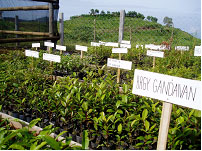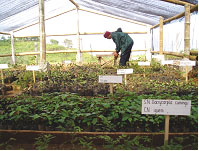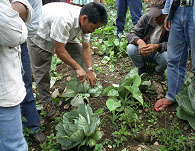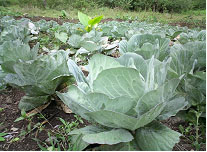 | |||||||||||||||||||||||
|
 |
 OPEN RESEARCH Conservation and Utilization of Endemic, Rare and Economically Important Plants in Three Barangays of Don Victoriano, Misamis Occidental The research project was conducted to select, identify, evaluate and mass propagate the endemic, rare, and economically important plants in the three barangays (Mansawan, Gandawan and Lake Duminagat) of Don Victoriano, Misamis Occidental by establishing a nursery, greenhouse and community garden involving the local community as an ex situ conservation strategy. Through the participation of the local community in selecting priority endemic, rare, and economically important plants for propagation and through the assistance of the local researchers, these plants were collected from the forests. There were three collection sites: Palo 6 (formerly under Brgy. Mansawan but now a part of Brgy. New Liburon); Sitio Pongol, Brgy. Gandawan and Linaw, Brgy. Lake Duminagat. Most of the wildlings and the other plants collected from the three sites which were potted in forest soil obtained from Palo 6 survived. The high percentage survival could be attributed to the moderate amount of organic matter present in the forest soil, 6.90%; 17.2982 ppm available phosphorus and 96.0 ppm exchangeable potassium. When the wildlings were potted in various potting media which included Mansawan garden soil, there was no significant difference as to percentage survival. This indicates that the wildlings could grow well in Mansawan garden soil even if it has low organic matter content, 1.05% and low phosphorus, 4.7824 ppm, but with high exchangeable potassium, 447.0 ppm. When the wildlings were out-planted along the roads and trails of Brgy. Mansawan after being hardened, most of them showed high percentage survival which is an indication that they could be easily propagated as reforestation species. Cuttings of Agathis philippinensis and Cinnamomum mercadoi subjected to hormone treatments showed that their percentage survival was not significantly different to those of the control. This means that they could be propagated by immersing in water only prior to propagation. Cuttings of two ornamental plants, Medinilla sp. and Lycopodium clavatum, showed high percentage survival when potted in Mansawan garden soil. For in vitro cultures, node explants of Agathis philippinensis formed apical bud in MS + 1 mg/L BA. There was shoot elongation in the in vitro cultured node explant of Callophyllum blancoi in MS + 0.5 mg/L BA. Likewise, there was high percentage survival of the germinated spores of Diplazium esculentum which eventually formed sporophytes when inoculated in spore culture medium + 2% glucose. The roots of the wildlings of Agathis philippinensis and Podocarpus rumphii showed nodule formation which could be an indication of mycorrhizal association. As a participatory project, the research results have paved the way
for the drafting of a barangay resolution in Mansawan that would segregate
an area in the barangay as a site for reforestation/rainforestation
whose tree planting activity will be participated in by the local community.   Conserving the Diversity of Selected Arthropods in Cabbage-Growing Areas in Mt. Malindang, Misamis Occidental through Participatory Integrated Pest Management (IPM) The project was conducted primarily to conserve the diversity of beneficial arthropods in cabbage-growing communities in Mt. Malindang through the implementation of integrated pest management (IPM). The most valuable vegetables grown in the three upland communities of Mt. Malindang, namely Mansawan, Gandawan and Lake Duminagat were cabbage, onion, sweet pepper, and chayote. Cabbage was the most preferred vegetable because of its high economic return. However, its production is greatly constrained by the diamondback moth (DBM), Plutella xylostella. The main hypothesis was that cabbage polyculture would have high populations of beneficial arthropods but low DBM population while cabbage monoculture would have high DBM but low populations of beneficial arthropods. Moreover, beneficial arthropods will be conserved in IPM plots but they will be decimated in farmers' plots because of frequent spraying of pesticides. Cabbage is not an indigenous crop in Mt. Malindang hence upland farmers did not have any indigenous control practices for its pests. Generally, pesticides were used to control cabbage pests. The DBM was the major pest of cabbage. Other pests included the cabbage leafminer (Liriomyza sp.), common cutworm (Spodoptera litura), black cutworm (Agrotis sp.), green peach aphid (Myzus persicae), cabbage worm (Crocidolomia pavonana), cabbage looper (Trichoplusia ni), leaf feeding beetles (Aulacophora similis) and curculionid beetle. Generally, cabbage monoculture had higher DBM larval population than polyculture. Less diverse beneficial arthropods were found in IPM in Gandawan than in Lake Duminagat due to frequent spraying of pesticides during the dry season. Parasitism by Aphidius sp. on aphids and Diadegma sp. on the DBM was high in wet season because of less pesticide application. Agroforestry harbored more spiders than IPM plots due to the presence of introduced citrus and weeds. Cabbage yield in IPM and farmers' plots was comparable during the first trial. The demonstration plot had the highest yield, followed by agroforestry and IPM plots while the lowest yield was obtained from the farmers' plots during the second trial. Economic analysis showed that IPM had the highest net income due to lower cost of pest control; agroforestry had the highest investment return compared to IPM plots because of zero pest control while the farmers' plots incurred the highest production cost attributed mainly to the costs of chemicals. The conduct of pre-implementation and post-implementation activities facilitated the smooth implementation of the project, established rapport among the team, local government officials and the local partners, and provided the opportunity to finally return significant findings of the project back to the community. Recognition of the different stages of cabbage pests was the greatest
impact of the project to the local partners and their wives. The weekly
exercise on agroecosystem analysis (AESA) enabled them to practice proper
timing of pest control, thus reducing pesticide use, recognized the
important role of beneficial arthropods in regulating pest population,
and consequently gained higher income and profit. Non-application of
pesticides when spiders were abundant, bagging and use of chicken dung
were already adopted by some local partners of the project.  
|
 |
|
|||||||||||||||||||
 |
|||||||||||||||||||||||
